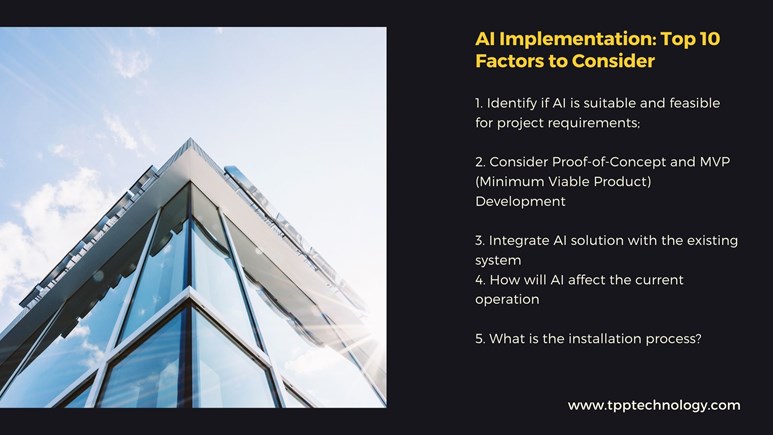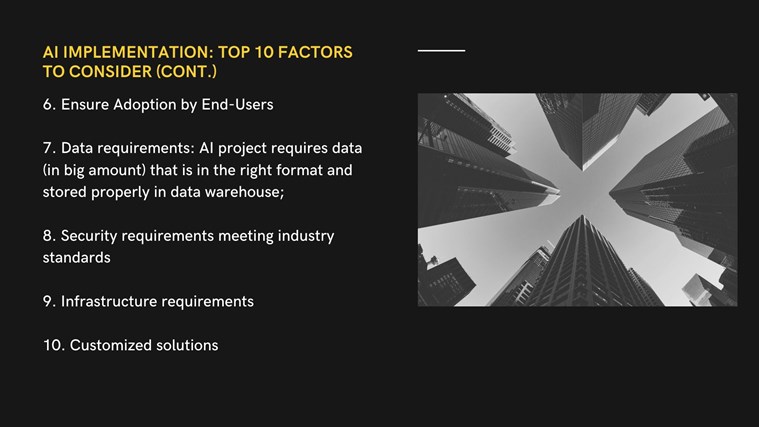
AI Implementation: Top 10 Factors to Consider
In our previous blog posts, we have mentioned that AI (Artificial Intelligence)/ML (Machine Learning) technology is being adopted by businesses across industries, from Manufacturing to Insurance and Finance to Retail, for optimizing of business processes to improve efficiency and profitability and so on.
However, many of the AI implementation efforts are delayed due to lack of strategy and resources readiness. To prevent your organization’s AI implementation effort from going to waste or getting dragged on more than expected, it’s critical that business plan ahead and be prepared before executing their AI solution program.
By preparing ahead, businesses will be able to have an understanding of the process and product, as well as accounting for any potential roadblocks that may arise during implementation.
Here are the 10 key factors to consider:
1. Identify if AI is suitable and feasible for your project requirements
Before business organizations embarking on their AI initiatives, businesses need to conduct research, preferably with their potential technology partner in order to identify whether AI is actually needed to solve their business problem.
Many times, a solution does not really require AI, and investing a huge amount of capital in the wrong place could be an unwise wise business decision.
Once it’s clear that AI is needed to solve the specific challenges, the next step is to find out if your AI project is actually feasible, because no AI solution can actually do it all.
Identify the key business problems and ask your technology partner if they can help with solving that problem using AI or not.
2. Consider Proof-of-Concept and MVP (Minimum Viable Product) Development
Many of the times, businesses would like to know if the potential AI solution can actually deliver before deciding to implement it. The answer to this could be a free trial if businesses opt for an out-of-the-box solution, or PoC (Proof-of-concept) or MVP development.
Read more about: Choosing between Prototype or MVP development in software development.
Unlike a full-scale AI solution which is costly and time-consuming to implement, MVP project doesn’t take long and deliver results quickly, allowing businesses to have a rough estimate on the ROI before committing to a long-term development project.
3. How will AI affect the current operation

One important question that needs to be asked is if the new AI solution can help eliminate some of your team repetitive tasks or this new system requires more input from your team.
If the new AI tool requires extra input from your team to work, then you should definitely evaluate the added value that the new system can bring to your business and if it’s worth the effort to change your existing business process.
4. Integrate AI solution with the existing system
The next important point is to assess whether the new AI system function as a stand-alone application or if your business requires the new AI solution to be integrated with the existing system of applications.
Integrating one new tool can significantly affect the way your team work, and overall, this will affect employees’ productivity. Thus, it’s critical to consider ROI and evaluate if it’s valuable enough to adjust your organization IT infrastructure and business application system.
5. What is the installation process?
Some AI solutions are easy to use and end-users do not have to be well-versed in tech to be able to use. However, each solution vary and some might need the solution provider and/or IT department to be involved to assist with the installation to get it up and running.
Thus, it’s important to identify the party that is responsible to setup the product as needed and get an estimate on the time required for set-up.
6. Ensure Adoption by End-Users
Ai solution could be a little different compared to some other traditional system, and thus may require training for end-users to use the system. To simplify and make the system easy to use for end users, ask for a user-friendly UI design and post-live support training (if needed) to allow users have a steady learning curve.
7. Data requirements
As mentioned previously, AI project requires data (in big amount) that is in the right format and stored properly in data warehouse.
Depends on the specific project requirements, businesses may require the new AI solution to capture and analyze complex data at various levels for optimization, no matter what the devices or channels. Moreover, data needs to be prepared according to the selected algorithms (i.e. by normalization).
Otherwise, it wouldn’t be possible to identify buried opportunities found in the hidden patterns in those vast amount of data.
8. Security requirements
AI is being applied in many businesses across various industries, and just like any other software solution security is an important matter that businesses need to take into consideration when upgrading and modifying their system to serve new business functions and users.
Business need to understand the impact of the potential security threats that may occur and take appropriate measures to protect their system from being attacked.
Many industries have their own regulation and standards when it comes to data security, for example HIPAA (healthcare), or KYC (Fintech) etc. so businesses need to make sure that the updating of their system is complied with those regulations.
9. Infrastructure requirements
Every AI solution is different in terms of implementation and some could require an in-house IT infrastructure that is suitable to get the solution up and running, at scale. Thus, having an understanding of what is required in terms of resources helps business to quickly adopt and put the new solution to use at scale to ensure business efficiency.
10. Customized solution
Every company is different and may have unique requirements when it comes to AI solution development. Thus, it’s especially important to ask the technology partner if they can provide the solution that meets your organization’s specific needs, especially if your data is confidential and can’t be handed-over to a 3rd party provider. For example, it could be a specialized workflow model or integration to work with other existing applications.
So, before finalizing any decision, it’s important to ensure that your technology partner is capable of providing customization for the AI solution as needed. And if your business does need a complex, not-standardized solution, you might need to establish an in-house AI capacity or contract a AI/ML Consulting Services Provider (like TP&P Technology) to build your custom solution.



